Tokyo is a continuously changing city, with a rate of demolitions and rebuilds higher than in most cities and I noticed many places changing from one year to another.
This made me wonder… are there places in Tokyo that still look like they did in the old Edo?
So, I choose as historical source the ukiyo-e paintings, and for this first quest I selected five of the Hiroshige’s One Hundred Famous Views of Edo.
1. The Nihonbashi Bridge - similarity degree: fair (considering the museum)
The first bridge from Nihonbashi was built in 1603 by the Shogun Tokugawa Ieyasu. The wooden bridge was called Edobashi (Edo Bridge).
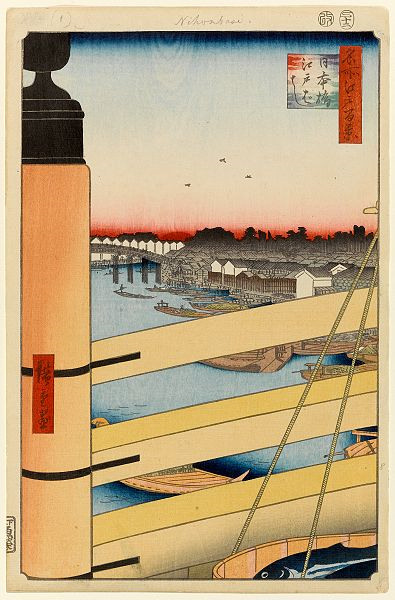 Hiroshige - One Hundred Famous Views of Edo - Nihon Bridge and Edo Bridge
Hiroshige - One Hundred Famous Views of Edo - Nihon Bridge and Edo Bridge
image via WikipediaWe can still see a replica of the old bridge at the Edo-Tokyo Museum…
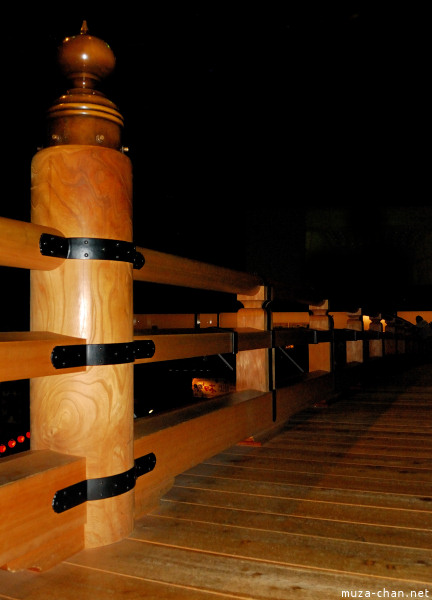 Nihonbashi Bridge, Edo Tokyo Museum
Nihonbashi Bridge, Edo Tokyo MuseumToday, on the same place, we can see a stone bridge, built in 1911 in the Renaissance architectural style.
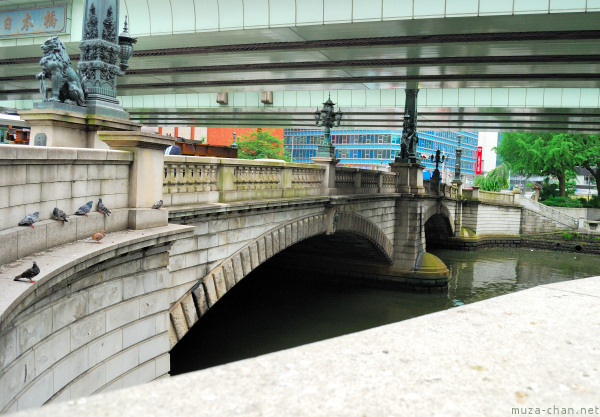 Nihonbashi Bridge
Nihonbashi Bridge2. The Kinryuzan Temple, Asakusa - similarity degree: good
The Kinryuzan Temple from Asakusa, well known today as the Senso-ji Temple, was initially built in 645, being the oldest temple in Tokyo.
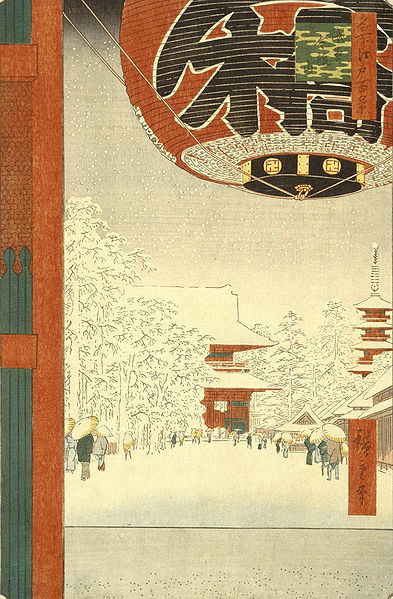 Hiroshige - One Hundred Famous Views of Edo - Kinryuzan Temple at Asakusa
Hiroshige - One Hundred Famous Views of Edo - Kinryuzan Temple at Asakusa
image via WikipediaMost of the buildings in this area were destroyed during the World War II, but most of the were rebuilt on the same premises, except for the five-storied pagoda, which was moved to the other side of the temple.
The famous paper lantern from the Kaminarimon Gate still looks the same as in the Edo period…
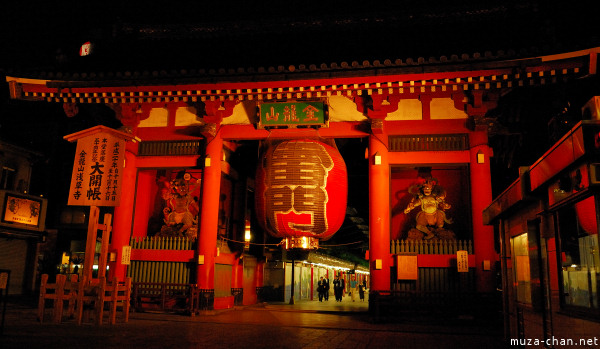 Kaminarimon Gate, Temple Asakusa
Kaminarimon Gate, Temple AsakusaAlso, the shops from the Nakamise-dori (the street connecting the two temple gates), that first appeared during the 18th century and are still there today, but looking a lot more modern…
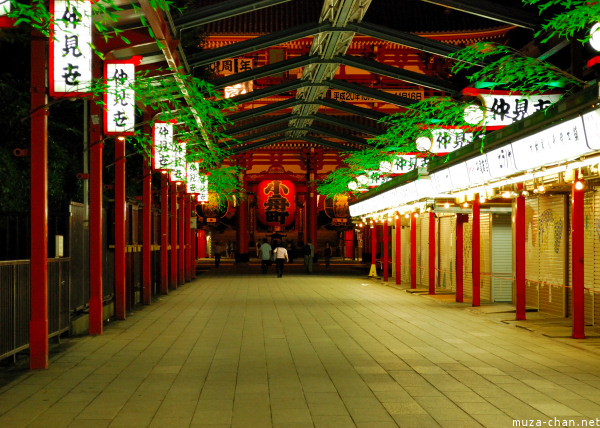 Nakamise Street, Senso-ji Temple Asakusa
Nakamise Street, Senso-ji Temple Asakusa3. The Kanda Myojin Shrine - similarity degree: poor
Kanda Myojin is one of the oldest shrines in Tokyo, built in 730 on the place where today is located the Otemachi district. In 1603 the shrine was moved in Kanda and later, in 1616, it was moved on a hill nearby Akihabara.
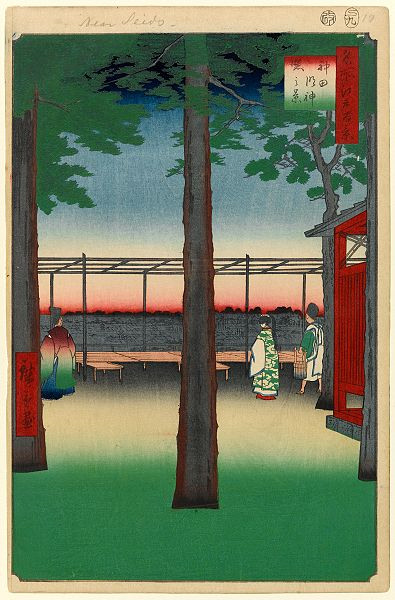 Hiroshige - One Hundred Famous Views of Edo - Dawn at the Kanda Myojin Shrine
Hiroshige - One Hundred Famous Views of Edo - Dawn at the Kanda Myojin Shrine
image via WikipediaThe present day building was rebuilt in 1934, after the Great Kanto Earthquake destruction from 1923. Inside the shrine’s courtyard we can still see three trees, exactly like in the ukiyo-e painting…
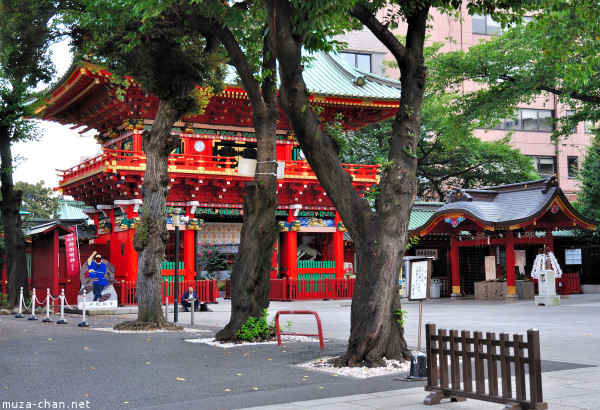 Torii at Kanda Myojin Shrine
Torii at Kanda Myojin Shrine4. The Hachiman Shrine from Fukagawa - similarity degree: none
The Tomioka Hachiman Shrine from Fukagawa is the biggest shrine in Tokyo dedicated to the Hachiman God and was founded in 1627.
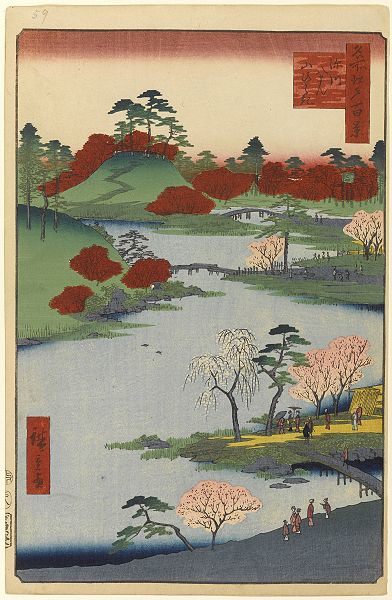 Hiroshige - One Hundred Famous Views of Edo - Cherry Blossoms at the Hachiman Shrine in Fukagawa
Hiroshige - One Hundred Famous Views of Edo - Cherry Blossoms at the Hachiman Shrine in Fukagawa
image via WikipediaThe shrine’s building was rebuilt after it was burned down during war, but the entire area is completely changed today, the shrine being surrounded by modern buildings.
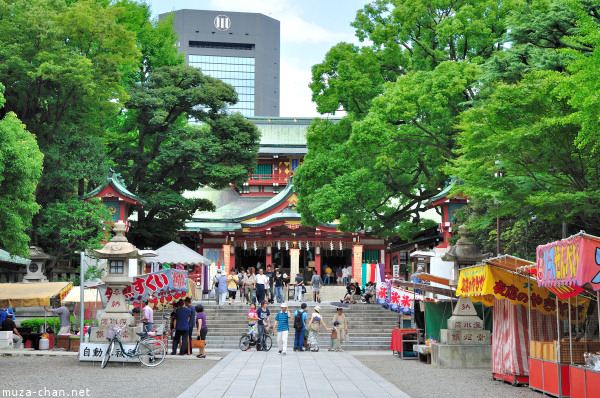 Hachiman Shrine, Fukagawa
Hachiman Shrine, Fukagawa5. The Benten Temple, Inokashira - similarity degree: excellent
The temple dedicated to the Goddess Benzaiten was first built in 1197, as a shrine to pray for peace, by Yoritomo Minamoto.
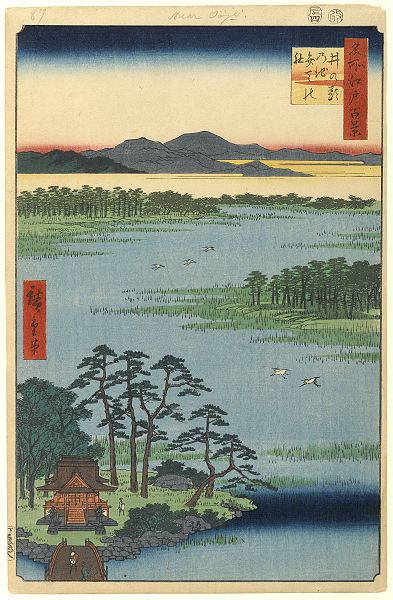 Hiroshige - One Hundred Famous Views of Edo - The Benten Shrine at Inokashira Pond
Hiroshige - One Hundred Famous Views of Edo - The Benten Shrine at Inokashira Pond
image via WikipediaThe Vermilion arched bridge located at the entrance of the temple still looks today exactly as it did in the Hiroshige’s painting and the surroundings haven’t changed much.
The temple is still in the middle of the park, surrounded by greenery…
 Benten Temple, Inokashira
Benten Temple, Inokashira
Tokyo este un oraş în continuă schimbare, se demolează şi se reconstruieşte continuu şi de la un an la altul am observat multe locuri care s-au schimbat complet.
Acest lucru m-a făcut să mă întreb: Oare au mai rămas astăzi locuri în Tokyo care arată la fel ca în vechiul Edo?
Am ales ca sursă istorică picturile ukiyo-e, iar pentru acest prim articol am ales cinci locuri din seria lui Hiroshige One Hundred Famous Views of Edo.
1. Podul Nihonbashi - grad de asemănare: acceptabil (ţinând cont şi de muzeu)
Primul pod din Nihonbashi a fost construit în anul 1603 de către shogunul Tokugawa Ieyasu. Podul era din lemn şi se numea Edobashi (Edo Bridge).
 Hiroshige - One Hundred Famous Views of Edo - Nihon Bridge and Edo Bridge
Hiroshige - One Hundred Famous Views of Edo - Nihon Bridge and Edo Bridge
image via WikipediaO replică a acestui pod se poate vedea la Muzeul Edo Tokyo.
 Nihonbashi Bridge, Edo Tokyo Museum
Nihonbashi Bridge, Edo Tokyo MuseumAstăzi, pe acelaşi loc, se află un pod din piatră, în stil Renaissance, care a fost construit în anul 1911.
 Nihonbashi Bridge
Nihonbashi Bridge2. Templul Kinryuzan, Asakusa - grad de asemănare: bun
Templul Kinryuzan din Asakusa, cunoscut astăzi cu numele de Senso-ji, a fost construit în anul 645, fiind cel mai vechi templu din Tokyo.
 Hiroshige - One Hundred Famous Views of Edo - Kinryuzan Temple at Asakusa
Hiroshige - One Hundred Famous Views of Edo - Kinryuzan Temple at Asakusa
image via WikipediaMare parte din clădirile din această zonă au fost distruse în timpul celui de-al doilea război mondial dar au fost reconstruite în acelaşi loc, cu excepţia pagodei cu cinci etaje care a fost mutată în cealaltă parte a templului.
Celebrul felinar din hârtie de pe poarta Kaminarimon a rămas la fel cu cel din perioada Edo.
 Kaminarimon Gate, Temple Asakusa
Kaminarimon Gate, Temple AsakusaÎncepând cu secolul al XVIII-lea, pe strada de un sfert de kilometru dintre cele două porţi ale templului (Nakamise-dori), au apărut magazinele care există şi astăzi.
 Nakamise Street, Senso-ji Temple Asakusa
Nakamise Street, Senso-ji Temple Asakusa3. Altarul Kanda Myojin - grad de asemănare: slab
Kanda Myojin este unul dintre cele mai vechi altare din Tokyo, construit în anul 730 pe locul în care astăzi se află districtul Otemachi. În 1603 a fost mutat în Kanda, iar în 1616 a fost mutat din nou pe un deal de lângă Akihabara, pe locul pe care se află şi astăzi.
 Hiroshige - One Hundred Famous Views of Edo - Dawn at the Kanda Myojin Shrine
Hiroshige - One Hundred Famous Views of Edo - Dawn at the Kanda Myojin Shrine
image via WikipediaClădirea actuală a fost reconstruită în 1934, după ce a fost distrusă de marele cutremur Kanto din 1923. În curtea altarului există şi astăzi trei copaci, exact ca în pictura ukiyo-e…
 Torii at Kanda Myojin Shrine
Torii at Kanda Myojin Shrine4. Altarul Hachiman, Fukagawa - grad de asemănare: deloc
Altarul Tomioka Hachiman din Fukagawa este cel mai mare altar închinat lui Hachiman din Tokyo şi a fost construit în anul 1627.
 Hiroshige - One Hundred Famous Views of Edo - Cherry Blossoms at the Hachiman Shrine in Fukagawa
Hiroshige - One Hundred Famous Views of Edo - Cherry Blossoms at the Hachiman Shrine in Fukagawa
image via WikipediaClădirea de astăzi a fost reconstruită dupa cel de-al doilea razboi mondial. Spre deosebire de vechiul Edo, zona este foarte populată, altarul fiind înconjurat de clădiri.
 Hachiman Shrine, Fukagawa
Hachiman Shrine, Fukagawa5. Templul Benten, Lacul Inokashira - grad de asemănare: excelent
Templul dedicat zeiţei Benzaiten a fost construit în anul 1197 de către Yoritomo Minamoto.
 Hiroshige - One Hundred Famous Views of Edo - The Benten Shrine at Inokashira Pond
Hiroshige - One Hundred Famous Views of Edo - The Benten Shrine at Inokashira Pond
image via WikipediaLa intrarea în templu se află şi astăzi un pod arcuit Vermilion care seamănă cu cel din pictura lui Hiroshige, iar împrejurimile nu s-au schimbat prea mult. Templul a rămas în mijlocul parcului, înconjurat de verdeaţă.
 Benten Temple, Inokashira
Benten Temple, Inokashira 












